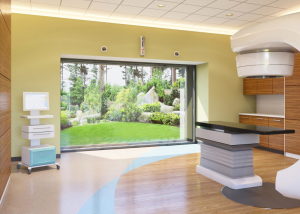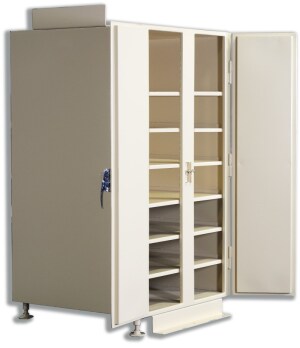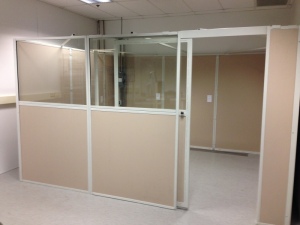
Veritas VPAC shielding modules being
craned into position between steel support
columns as part of a two-room treatment
center in the U.K.
craned into position between steel support
columns as part of a two-room treatment
center in the U.K.
Radiation shielding in the era of patient satisfaction
September 25, 2017
by John W. Mitchell, Senior Correspondent
As hospitals focus increasingly on patient satisfaction, the radiation shielding industry has found ways to make imaging and therapeutic environments more comfortable and less intimidating, while also enhancing aspects of workflow.
According to a Reportbuyer market analysis from last year, radiation shielding is nearly a $1 trillion industry. HealthCare Business News reached out to three companies in the sector, Veritas Medical Solutions, MarShield and Nelco Worldwide, to find out what trends they are seeing in the industry and how they aim to set themselves apart from one another and their competitors, which also include companies like ETS-Lindgren, Ray-Bar Engineering and Gaven Industries, just to name a few.
Historically, shielded environments have been somewhat cavernous spaces, contained and detached from the world outside those heavy walls. Incorporating a scenic view with natural light into those barricaded spaces is part of what David Farrell, president and CEO of Veritas Medical Solutions, calls creating a “healing environment.” In the second half of last year, his company began offering SmartVue Natural Light Windows to facilities wanting to invest in a less claustrophobic radiation atmosphere.
"Our emphasis has been developing methods of opening up the shielding barrier to allow the entrance of natural light into the treatment area," he told HCB News. "Designer finishes, better aesthetics and the incorporation of natural outside elements into the treatment area are all being included to make the treatment area more comforting and soothing for the patients."
A ray of light for the patient experience
The 11-by-7-foot SmartVue window operates by way of two sliding leaves incorporated into the secondary shielded wall that closes during the treatment process. The rest of the time, when the linear accelerator is not operating, the window stays open to comfort patients with natural light. A scenic view is also created with landscaping outside of the window.
According to Farrell, facilities are increasingly on the lookout for turnkey solutions for fully designed and constructed medical campuses.
"They’re looking for the easiest and fastest method of constructing a fully outfitted cancer treatment facility, which incorporates not just the shielded bunkers, but also the surrounding service areas and other necessary spaces," he said.
To meet this demand, Veritas offers a series of modular building and shielding systems that can be prefabricated off-site. The segments are trucked to the clinical site and craned into position, which reduces construction time.
Using this approach, a shielded vault can sometimes be constructed in less than a week, compared to an average install of 12 weeks for the conventional model.
Temporary solutions and evolving storage technology
Radiation shielding demands are not limited to the treatment environment. Facilities require smaller shielding solutions, such as special cabinets and other forms of storage, to mitigate the potential danger of having radioactive products and refuse on site.
"There is a need for shielding for both waste and storage on radioactive source vials in nuclear medicine. These sources emit fairly high levels of radiation that would cause long-term health effects to those administering the dose and anyone within the vicinity of the source," Justin Parrington, marketing sales executive with MarShield, told HCB News. "When you have potentially hundreds of doses stored, the effects of the radioactivity are amplified."
Facilities frequently want sheet lead, lead bricks, lead barriers, lead cabinets, lead storage containers and lead drywall. Using manufacturing techniques that have evolved alongside the needs of its customers, MarShield seeks to maximize thickness and the capacity of the hardware to handle additional weight.
"Radiation shielding, by nature, is very heavy as there is a direct correlation with density and attenuation," says Parrington. "We design shielding for ease of movement, installation and practicality by using hardware to accommodate for lids on storage and waste containers that can weigh hundreds of pounds and cabinets that weigh up to several thousand pounds."
Parrington also reports that there is a growing demand for portable radiation testing rooms by clients who have a short-term need.
"Rather than use a permanent design in a leased facility, it makes more sense for some customers to have a room that can be easily installed and removed quickly, without the need for structural redesign" he says.
While many customers are expanding into tight, urban footprints, Parrington says they are discovering new sources of space.
"In most urban areas, there are enough buildings available for lease as we are moving toward an online retail society," he says. "These are existing, desirable locations for a customer base, and if the facility can be retrofit to a small medical facility, then it makes more sense than assuming the cost for a new build."
About 80 percent of MarShield’s business is driven by these remodels, which Parrington notes are more complicated projects than new constructions.
Partnering with the right organizations
Nelco Worldwide, which a company source said is the only company in the sector certified by the International Standard of Operations, cites its varied shielding experience for both diagnostic and treatment modalities. For the ground-up construction of the El Paso Center for Integrative Medicine, for example, Nelco designed the shielding for the facility's PET/CT room, linear accelerator vault and the medical oncology space.
The company boasts projects completed in 48 of the top 50 cancer centers in the U.S. and recently inked a co-marketing agreement with IBA for custom, modular radiation shielding solutions for the ProteusONE proton therapy system.
Nelco also specializes in retrofitting existing spaces. In May, the company used its high-density concrete blocks and Guardian swing door to build out a new treatment facility bunker at the Northern Beaches Cancer Care Centre in Sydney, Australia, in five weeks.
Mazes clear the way for sliding doors
Perhaps one of the biggest trends in radiation shielding is the move away from maze entryways to more direct, sliding doors to access treatment spaces.
"Customers immediately recognize the advantages that the direct entry design can bring to their facility, not only with respect to actual construction time or cost, but also with respect to patient and staff experience and greatly increased space utilization," says Veritas Medical Solutions’ Farrell.
Direct entry, he added, increases patient throughput. And due to the redundancy of two doors, the feature also improves safety and reduces door maintenance.
Above all, Farrell added, it's important to be responsive to customers who have the best interest of their patients in mind.
"Our customers are always looking for solutions. No matter how many ‘standard’ products you may offer, every facility has its own special needs or unique challenges," he says.
According to a Reportbuyer market analysis from last year, radiation shielding is nearly a $1 trillion industry. HealthCare Business News reached out to three companies in the sector, Veritas Medical Solutions, MarShield and Nelco Worldwide, to find out what trends they are seeing in the industry and how they aim to set themselves apart from one another and their competitors, which also include companies like ETS-Lindgren, Ray-Bar Engineering and Gaven Industries, just to name a few.
Historically, shielded environments have been somewhat cavernous spaces, contained and detached from the world outside those heavy walls. Incorporating a scenic view with natural light into those barricaded spaces is part of what David Farrell, president and CEO of Veritas Medical Solutions, calls creating a “healing environment.” In the second half of last year, his company began offering SmartVue Natural Light Windows to facilities wanting to invest in a less claustrophobic radiation atmosphere.
"Our emphasis has been developing methods of opening up the shielding barrier to allow the entrance of natural light into the treatment area," he told HCB News. "Designer finishes, better aesthetics and the incorporation of natural outside elements into the treatment area are all being included to make the treatment area more comforting and soothing for the patients."
A ray of light for the patient experience
The 11-by-7-foot SmartVue window operates by way of two sliding leaves incorporated into the secondary shielded wall that closes during the treatment process. The rest of the time, when the linear accelerator is not operating, the window stays open to comfort patients with natural light. A scenic view is also created with landscaping outside of the window.
According to Farrell, facilities are increasingly on the lookout for turnkey solutions for fully designed and constructed medical campuses.
"They’re looking for the easiest and fastest method of constructing a fully outfitted cancer treatment facility, which incorporates not just the shielded bunkers, but also the surrounding service areas and other necessary spaces," he said.
To meet this demand, Veritas offers a series of modular building and shielding systems that can be prefabricated off-site. The segments are trucked to the clinical site and craned into position, which reduces construction time.
Using this approach, a shielded vault can sometimes be constructed in less than a week, compared to an average install of 12 weeks for the conventional model.
Temporary solutions and evolving storage technology
Radiation shielding demands are not limited to the treatment environment. Facilities require smaller shielding solutions, such as special cabinets and other forms of storage, to mitigate the potential danger of having radioactive products and refuse on site.
"There is a need for shielding for both waste and storage on radioactive source vials in nuclear medicine. These sources emit fairly high levels of radiation that would cause long-term health effects to those administering the dose and anyone within the vicinity of the source," Justin Parrington, marketing sales executive with MarShield, told HCB News. "When you have potentially hundreds of doses stored, the effects of the radioactivity are amplified."
Facilities frequently want sheet lead, lead bricks, lead barriers, lead cabinets, lead storage containers and lead drywall. Using manufacturing techniques that have evolved alongside the needs of its customers, MarShield seeks to maximize thickness and the capacity of the hardware to handle additional weight.
"Radiation shielding, by nature, is very heavy as there is a direct correlation with density and attenuation," says Parrington. "We design shielding for ease of movement, installation and practicality by using hardware to accommodate for lids on storage and waste containers that can weigh hundreds of pounds and cabinets that weigh up to several thousand pounds."
Parrington also reports that there is a growing demand for portable radiation testing rooms by clients who have a short-term need.
"Rather than use a permanent design in a leased facility, it makes more sense for some customers to have a room that can be easily installed and removed quickly, without the need for structural redesign" he says.
The MarShield portable X-ray room used for medical imaging
device testing contains lead glass, barrier walls and a sliding door
device testing contains lead glass, barrier walls and a sliding door
While many customers are expanding into tight, urban footprints, Parrington says they are discovering new sources of space.
"In most urban areas, there are enough buildings available for lease as we are moving toward an online retail society," he says. "These are existing, desirable locations for a customer base, and if the facility can be retrofit to a small medical facility, then it makes more sense than assuming the cost for a new build."
About 80 percent of MarShield’s business is driven by these remodels, which Parrington notes are more complicated projects than new constructions.
Partnering with the right organizations
Nelco Worldwide, which a company source said is the only company in the sector certified by the International Standard of Operations, cites its varied shielding experience for both diagnostic and treatment modalities. For the ground-up construction of the El Paso Center for Integrative Medicine, for example, Nelco designed the shielding for the facility's PET/CT room, linear accelerator vault and the medical oncology space.
The company boasts projects completed in 48 of the top 50 cancer centers in the U.S. and recently inked a co-marketing agreement with IBA for custom, modular radiation shielding solutions for the ProteusONE proton therapy system.
Nelco also specializes in retrofitting existing spaces. In May, the company used its high-density concrete blocks and Guardian swing door to build out a new treatment facility bunker at the Northern Beaches Cancer Care Centre in Sydney, Australia, in five weeks.
Mazes clear the way for sliding doors
Perhaps one of the biggest trends in radiation shielding is the move away from maze entryways to more direct, sliding doors to access treatment spaces.
"Customers immediately recognize the advantages that the direct entry design can bring to their facility, not only with respect to actual construction time or cost, but also with respect to patient and staff experience and greatly increased space utilization," says Veritas Medical Solutions’ Farrell.
Direct entry, he added, increases patient throughput. And due to the redundancy of two doors, the feature also improves safety and reduces door maintenance.
Above all, Farrell added, it's important to be responsive to customers who have the best interest of their patients in mind.
"Our customers are always looking for solutions. No matter how many ‘standard’ products you may offer, every facility has its own special needs or unique challenges," he says.




